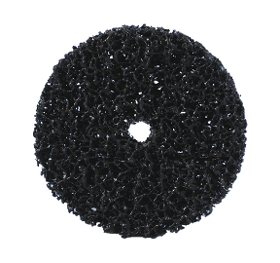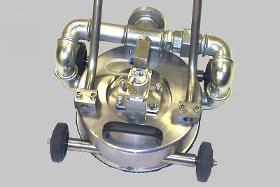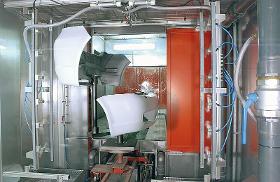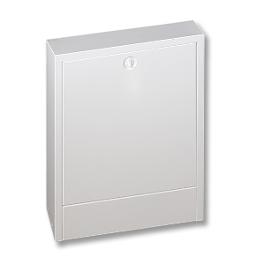- europages
- >
- COMPANIES - SUPPLIERS - SERVICE PROVIDERS
- >
- paint remover
Results for
Paint remover - Import export

FRIEDRICH AUGUST PICARD GMBH & CO. KG
Germany
Cleaning discs FAPI-CLEAN provide very good results when grinding and cleaning metal, stainless steel, wood or plastic and can therefore be used as a preliminary stage for grinding/polishing. We will be happy to advise you by telephone or at your site whether the use of cleaning discs FAPI-CLEAN also makes sense in your company for your processes. Construction Cleaning discs FAPI-CLEAN consist of knitted nylon threads which have been soaked in synthetic resin and gently cured. They are available on fabric plates and for use on straight and shaft grinders. Applications The cleaning discs are suitable for cleaning and polishing all surfaces. Scratch-free removal of paint, rust, scale and welding spots from metal Cleaning wood and plastic Remove paint from wood Free stainless steel from blue colouring Dimensions For cleaning discs FAPI-CLEAN the principle applies that they may only be used in conjunction with a clamping shank. Notice: For cleaning discs, the principle applies...
Request for a quote
KAMAT GMBH & CO. KG
Germany
Our Surface Cleaner 3000 air is an extremely powerful high pressure cleaner. It is capable of cleaning at pressures of up to 3,000 bar. To make it even more efficient and smooth in operation, we have fitted it with pneumatically driven rotating nozzles. This ensures an even cleaning process at all times. A common application for our hp floor cleaner is the removal of rubber residue from airport runways. All our surface cleaners can be fitted with a vacuum. This ensures a trouble-free and dirt-free working environment, improves visibility and workplace safety and reduces the impact of the process on the environment.
Request for a quote
RIPPERT ANLAGENTECHNIK GMBH & CO. KG
Germany
With high-quality filter tubes and PTFE diaphragms. Paint dust filters Wet painting also results in overspray. Overspray is the solid portion of the paint that is not taken up by the workpiece. According to the purpose of use, the overspray is moist and sticky immediately after release. It is captured by the exhaust air stream in the spray booth and fed to a filter. This can be, for example, a baffle plate filter, paper filter, fleece filter, glass fibre filter or also combinations of these. The adhesive effect causes the paint particles to adhere to the contact surfaces of the respective filter medium, as a result of which a good degree of separation is achieved. However, all these filters are storage filters, i.e. the filters clog up more and more during operation and cannot be regenerated. A filter exchange becomes necessary if the exhaust air rate of the spray booth falls below the minimum. This can be very time-consuming under certain circumstances and the work process must be interrupted in order to do it. To make things worse, not only must the filtered and bound paint residues be disposed of, but also the actual filter materials. Such tooling times are not justifiable for automatic, continuous or multi-layer painting processes. Continuous procedures such as automatically cleaned filters are likewise required for this. The humidity and the adhesiveness of the particles to be filtered are thereby the problem. In order to solve this problem, the paint particles should be relieved of their adhesive capability as far as possible whilst still inside the paint booth. Our patented ‘RTS-Rotation’ system is outstandingly well suited for this. The system is comprised of slowly rotating brush rollers, which take up the adhesive paint particles on the surface of the bristles and allow them to dry there. The bristles are automatically regenerated at pre-specified time intervals by combing devices that swing in at the rear of the brush rollers. The dislodged paint residues can then be removed and disposed of either manually during work breaks or automatically during operation. The degree of separation of this system is, however, insufficient to satisfy the environmental protection requirements concerning residual dust content in the exhaust air. A further filter stage is necessary for that. It must be assumed that the paint particles arriving here are to a certain extent still damp and sticky. For this we use special paint dust filters with high-quality filter tubes with PTFE diaphragms. If necessary, precoating agents (auxiliary dust) are used in order to neutralise the adhesive capability of the particles and to keep the dust layer on the filter elements permeable to air. The precoating agent is injected into the raw air pipe by means of special dosing units. The filter tubes are cleaned by means of compressed air impulse cleaning. The use of this technology requires special know-how. We have had the appropriate experience for almost ten years. The implemented plants have capacities ranging from 5,000 to 90,000 m³ /h. Because of the large number of different paint systems, individual experiments are usually necessary in our pilot plant in order to find the correct solution for the individual case.
Request for a quote
RIPPERT ANLAGENTECHNIK GMBH & CO. KG
Germany
The majority of plastics used today are very susceptible to the formation of electrostatic charges on the surface. The result of this is that the surfaces are strongly attractive to particles floating in the surrounding air. These adhering particles must be removed before painting. Dirt is difficult to remove from three-dimensional or structured surfaces using conventional methods. Components such as goods carriers, which are used continuously in circulating operation, are usually also difficult to clean on account of their geometry. The dynamic ionisation station has been developed especially for these applications. The goods carriers with the three-dimensional workpieces usually pass through the ionisation station standing on, or suspended from conveyor systems. Ionisation electrodes installed in the inlet and outlet generate positively and negatively charged ions, which are transported by the flow of air to the plastic surfaces. The static surface charges are neutralised as a result. The rotary cleaning nozzles located in-between remove adhering particles from the surfaces of the workpieces using cleaned compressed air. Dust and material particles are blown away by a pulsating air flow from different directions due to the rotation of the nozzles. This highly effective method enables even dirt on shaped parts to be cleaned off reliably. The particles cleaned off in this station are fed to a filtered extraction device by targeted air guidance.
Request for a quote
SANHA GMBH & CO. KG
Germany
SANHA®-Heat Distribution cabinet, surface-mounted, galvanically zinc-coated steel sheet, painted white (RAL 9010), with removable door and locking bolt, installation depth 125 mm.
Request for a quoteDo you sell or make similar products?
Sign up to europages and have your products listed
Results for
Paint remover - Import exportNumber of results
5 ProductsCompany type